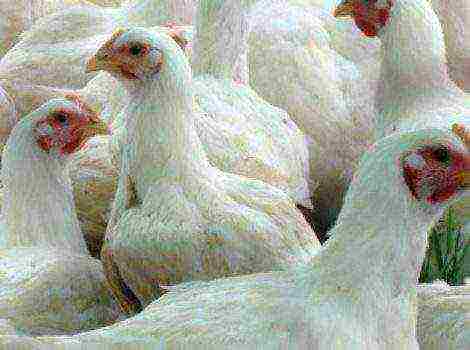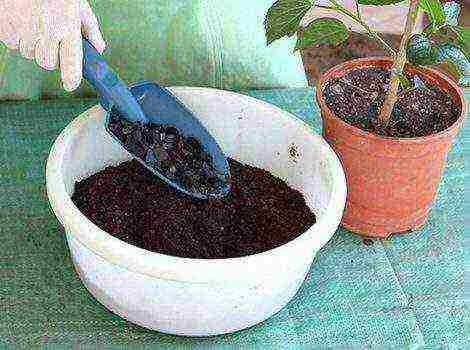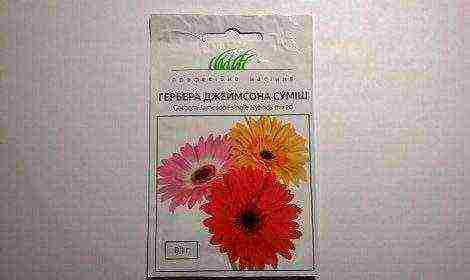Content
Petunia (Petunia) is one of the most common flowers in flowerpots, flower beds and hanging baskets. This plant was first found in Uruguay in the vicinity of Montevideo in 1793. A little later, several dozen more species of petunias were discovered in South America. This flower became a godsend for breeders, and in 1834 the first hybrid petunia bloomed. Today there are several dozen species and many varieties and hybrids of petunias, so it is easy to get confused in the complex taxonomy of this plant.
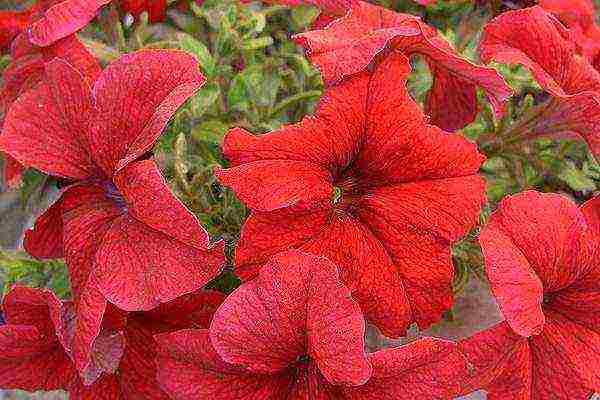
Petunia is a perennial. However, in culture, it is more often grown as an annual plant. Every year, seeds are sown in the spring, and in the fall, the fading petunia is sent to a humus heap or thrown into the trash. Many amateur flower growers believe that in the middle lane this is the simplest solution. In the southern regions, petunia is self-seeding.
At the beginning of autumn, I regretfully look at the petunias that continue to bloom, which are soon destined to be in a humus heap. They are poorly adapted to the autumn cold and frost, so their lifespan is predetermined. Beautiful plants do not have time to fully develop their potential over the summer. Even in the fall, a lot of vitality remains in them. Petunias are capable of becoming a mother plant from which strong stem cuttings can be cut. Or a flowering houseplant competing with exotic flowers.
We transfer petunia to the house
In nature, petunia is a perennial plant that can be used in its cultivation and reproduction. To do this, in the fall, before the cold snap and frost have begun (petunias that fall under them often die), we select several specimens, free them from long shoots and cut off all the spoiled leaves. The remaining bush should be compact and short. Not more than 15 cm in height. Better below. Before you bring the petunia into the room, you need to carefully examine its leaves (especially their underside) so that the whitefly and the testicles laid by it do not get into the house. The end of summer and the beginning of autumn is the time of the massive presence of this pest on cultivated and weed plants, but we often do not pay attention to the inconspicuous small whitefly. Until she appears on our indoor flowers.
If a whitefly or its eggs are found on the leaves of petunia, then urgent measures must be taken before bringing the pot with the plant into the house. The best place for him is a cold light windowsill, a veranda, a glazed loggia (balcony), a light basement, etc. We are not talking about specially equipped places and greenhouses, in which queen cells are grown with additional lighting and the necessary humidity.
It seems that at first petunia is thinking about how she will behave further. Sometimes it suddenly wakes up, gives new shoots and even blooms. Or it stops growing, hibernating until the end of winter. It is important to create conditions for petunias so that young shoots do not weaken the plant. No growth stimulants and fertilizers are used during this period. The exception is Zircon and Epin (only if necessary).
In March (sometimes from the end of February), the container with petunia must be moved to the brightest place. It must be cool (not lower than + 6 ° С). We establish watering and feeding.This mode allows the mother plant to grow enough so that full stem cuttings can be cut in April.
In winter, the condition of the petunia sometimes deteriorates sharply. There are several reasons: either it is powdery mildew and its consequences, whitefly, etc. Often the plant loses strength in an insufficiently bright and warm room. Many troubles are associated with waterlogging of the soil. If the leaves dry up and fall off, and the stems turn black or dry out, then this is a clear sign: the petunia feels very bad. Normally, only partial yellowing of the leaves.
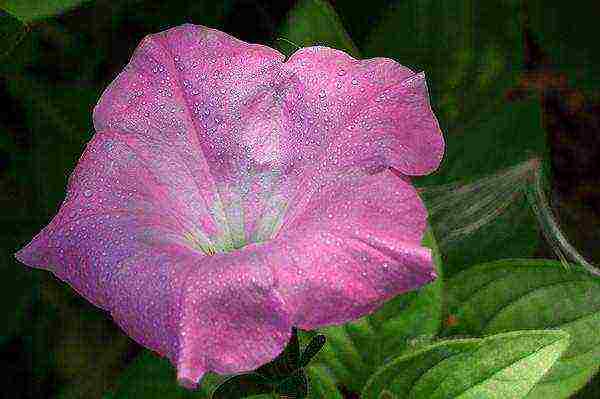
Cutting as a simple breeding option for petunias
Petunia is beautifully cuttings. Many times in the summer I stuck a broken off flowering shoot into the soil, and it continued to live. This property is used by professionals and flower lovers, collecting "tribute" from the mother plants, in order to then propagate the variety they like. Cuttings are cut with and without a heel. The minimum cutting size is 2 - 3 pairs of leaves.
There are no special tricks for rooting cuttings. They are planted to a depth of about 1.5 - 2 cm in a container filled with loose fertile soil, covered with a jar and kept in the light. In order for the cuttings to lose less moisture, it is enough to leave just a couple of leaves. The lower pair of leaves should be completely removed, the upper leaves should be shortened by ½.
Care comes down to watering and airing. Condensation must not be allowed. A convenient mini-greenhouse is obtained from the upper part of a transparent plastic bottle, in the lid of which holes are made with a hot nail or drill. Tall transparent plastic cups with holes at the bottom can also be used as caps. But spraying cuttings with water must be treated with caution. Excessive dampness, rot and mold often appear from this procedure. Some amateur flower growers root petunia cuttings in jars of water.
The temperature at which rooting takes place is about 22 - 23 ° C. It is good if there is bottom heating. For example, a battery located close to a windowsill. The first leaves of young shoots appear very quickly. Without additional lighting or sunlight, they grow weak. Rooted cuttings are pinched, which causes further tillering. During the winter, the cutting, which began to root in August - September, turns into a beautiful flowering bush. It is looked after as a light-loving indoor plant.
You can try another way to keep petunias in winter. I mastered it quite by accident. It turned out that my petunia by August grew into such huge bushes that they covered other flowers and took up too much space in the flower garden. I shortened them and put the bouquet of tops into a flower pot with garden soil. She put the pot near the house and from time to time watered the "bouquet" from a watering can. Petunia quickly rose, began to grow and continued to bloom. In September, I put the pot on a glazed loggia. In winter, I sprayed petunia several times with a highly diluted solution of cheap (!) Washing powder. It can be replaced with soda ash. I didn't want to use chemistry. This preventive measure made it possible to avoid powdery mildew, a bloom of which often appears in the autumn-winter period and destroys petunias. I cut off most of the buds so as not to weaken the plant. Individual flowers were left "for beauty." It would be possible to leave all the flowers and buds, but for this it would be necessary to organize a stronger backlight.
In May, I shortened some of the elongated shoots of the "bouquet", having received a lot of fresh cuttings. The overgrown petunia (the former "bouquet") was divided into several parts and transplanted into a flower garden. Petunia grows quickly and does not like tightness, so it is better to plant its rooted cuttings "for growth".
Conclusion
In winter, petunia can be preserved as a mother plant for further rooting of its cuttings.Grown from rooted cuttings (cuttings are carried out in August - September), petunia becomes an elegant flowering houseplant, which can later be transplanted into a flower garden, flowerpot or hanging basket and cut its shoots. The main problem associated with the health of petunias in winter is powdery mildew. But this is already a consequence of some oversights in agricultural technology.
To keep abreast of all the news of the site, subscribe to our channel
Telegram ... We also have
 Cold weather is approaching, and petunia on your site or balcony continues to delight in lush color. Soon this beauty will end, but it's a pity ... Well, there is nowhere to go from the cycle of seasons, but you can try to save petunia bushes for the winter. Petunia, in essence, is a thermophilic perennial, therefore, by creating “southern” conditions for it, we can extend its life. So, now we will reveal the secret of how to preserve petunia in winter.
Cold weather is approaching, and petunia on your site or balcony continues to delight in lush color. Soon this beauty will end, but it's a pity ... Well, there is nowhere to go from the cycle of seasons, but you can try to save petunia bushes for the winter. Petunia, in essence, is a thermophilic perennial, therefore, by creating “southern” conditions for it, we can extend its life. So, now we will reveal the secret of how to preserve petunia in winter.
Wintering petunias - action for the elite
We hasten to warn you right away: keeping petunia bushes in winter is not an easy task. Although, this is the best way out if you want to keep an especially expensive, luxurious variety that does not produce seeds or does not retain all its properties in daughter plants. For example, this is useful for surfinias, supertunias and many other F1 hybrids.
There are 2 options for saving petunias for the winter:
- in the form of mother plants
- in the form of cuttings
Option number 1. Preservation of uterine bushes of petunias in winter
Adult petunia bushes can be saved until spring if they are transferred to a bright and frost-free room. It should be light, humid enough, optimal t = 10-15 ° C (but less will do, the main thing is that the temperature does not drop below 0 ° C). Suitable conditions are on closed verandas, insulated or southern loggias, on the window sills of entrances.
Petunia bushes are dug up, transplanted into pots and brought into the room. You need to have time to do this before frost, that is, in September-November. Dry leaves, damaged, rotten branches are cut off from the plant. A cardinal haircut is also practiced: all branches are cut to 10-15 cm.
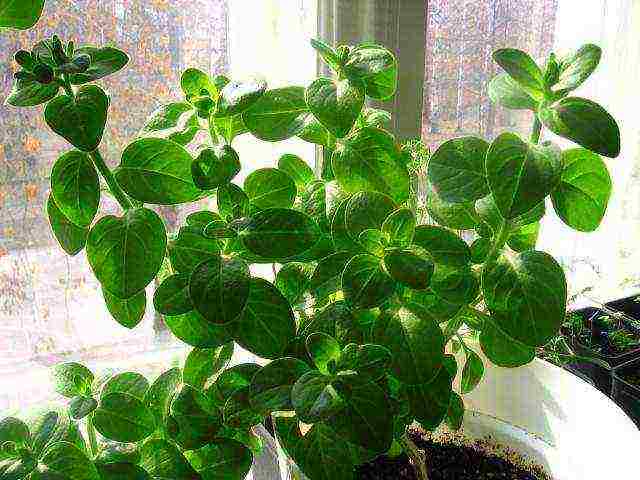 A petunia bush can overwinter on a cold windowsill
A petunia bush can overwinter on a cold windowsill
The main conditions for caring for petunia bushes in winter:
- minimum watering (up to 2-3 times a month);
- lack of fertilizers;
- high air humidity;
- temperature 10-15 ° C;
- good lighting.
In such conditions, petunias safely survive the winter and bloom in mid-February! Then more frequent watering and feeding can be "introduced" into the diet.
A petunia bush that has survived the winter is planted in open ground or in balcony containers. Or they do it differently: they propagate the petunia by cuttings and grow young petunia plants. The latter option is more common among florists. It is believed (and not unreasonably!) That young petunias bloom better than second years.
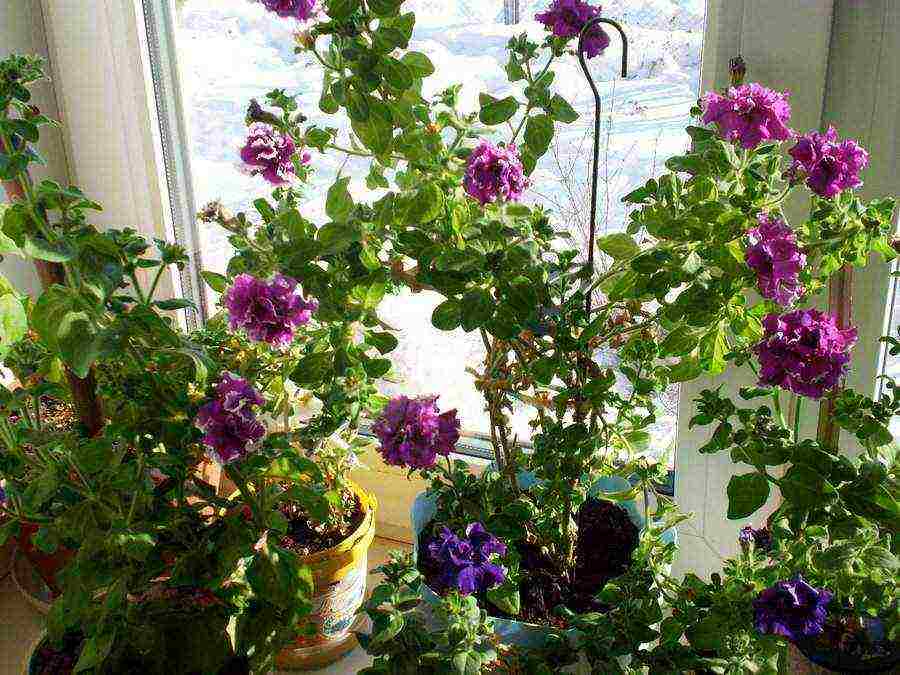 February bloom of petunia in the second year of life
February bloom of petunia in the second year of life
How is petunia cuttings carried out?
In spring, cuttings of 5-10 cm are cut from the overwintered petunia bush - green, not lignified. The lower leaves on the cutting are cut off so that a bare stem 1-3 cm long remains at the base.It is important that there is at least 1 pair of internodes in this area. 2-3 leaves should remain in the upper part of the cutting. If they are large, then their plates are cut in half across to reduce moisture evaporation.
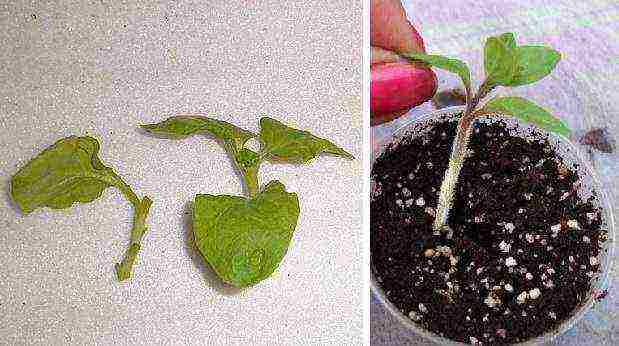 Petunia cuttings are planted in loose soil, preferably with baking powder. Can be used for rooting pure vermiculite or peat
Petunia cuttings are planted in loose soil, preferably with baking powder. Can be used for rooting pure vermiculite or peat
The bare part of the stem is deepened into moist, loose soil.
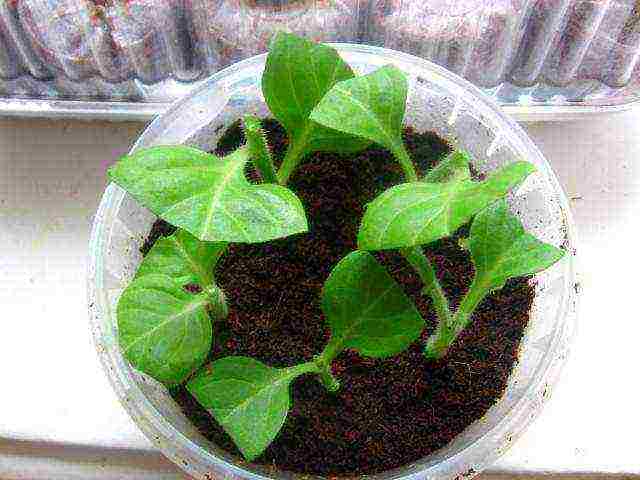 The leaves of the cuttings can be cut in half to reduce moisture loss through the leaf plates
The leaves of the cuttings can be cut in half to reduce moisture loss through the leaf plates
A vapor barrier is arranged on top to maintain high humidity around the cuttings. For example, cover the planting container with a plastic cup, glass jar or glass. Every day, the "greenhouse" is ventilated to prevent mold, rot, and black legs from appearing on the handle.
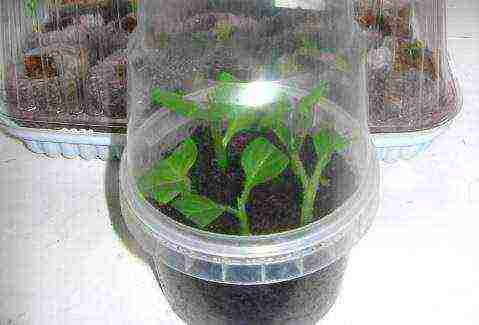 For ventilation, holes are made in the bottom of the plastic cup-"greenhouse"
For ventilation, holes are made in the bottom of the plastic cup-"greenhouse"
After about 10-14 days, young shoots will appear in the axils of the cuttings - this means that rooting has taken place! The greenhouse is removed, the cuttings continue to grow in the same way as petunia seedlings: they water, fertilize, spray. Above 5-6 leaves, young plants are pinched for tillering.
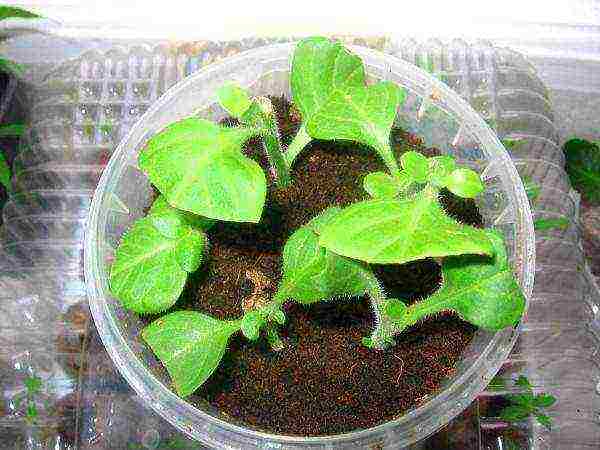 After 2 weeks, new shoots appear in the leaf axils of petunia cuttings
After 2 weeks, new shoots appear in the leaf axils of petunia cuttings
How to cut petunia is described in the video plot:
In March-April (depending on the region), when stable positive temperatures of 10-12 ° C are established, the rooted cuttings are planted for permanent residence - in open ground or in balcony containers.
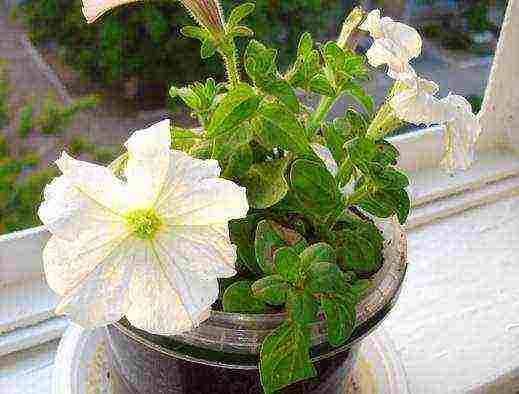 Flowering cuttings of petunia grown from the mother bush - "second year" Option №2. Preserving petunias in winter by cuttings
Flowering cuttings of petunia grown from the mother bush - "second year" Option №2. Preserving petunias in winter by cuttings
Keeping petunia mother liquor in winter requires special conditions - high humidity and low temperatures. In a city apartment, with a non-glazed (or glazed, but cold northern) balcony, such a climate is almost impossible to recreate.
In living quarters, not adult petunias have a better chance of survival, but rooted cuttings. They do not need special conditions and need to take care of them in the same way as indoor flowers. This method will also help those flower growers who do not want to clutter verandas, balconies and loggias in winter with large containers with petunia queen cells. Cuttings in cups on the windowsills take up very little space!
For winter storage, petunia is cut at the end of August-September. In this petunia cuttings propagate easily, since the life processes in it are not slowed down yet. The plants develop roots 5-10 days after planting.
Cuttings 5-10 cm long are cut from petunias, planted in cups, and covered with a "greenhouse". After rooting, they are placed in a cool, bright place. For example, on the windowsill, closer to the glass. To increase the moisture content of the content, a jar of water can be placed near the young petunias.
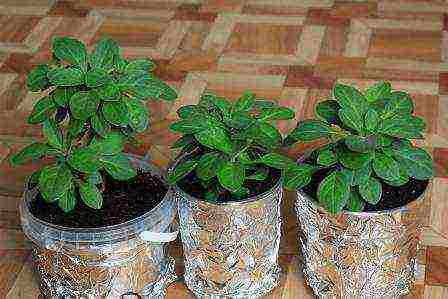 Young petunia cuttings in winter require as much attention as ordinary indoor flowers.
Young petunia cuttings in winter require as much attention as ordinary indoor flowers.
The main conditions for keeping rooted cuttings of petunia in winter:
- sufficient watering - after drying the topsoil;
- spraying;
- lack of fertilizers;
- increase in air humidity (containers with water next to the cuttings).
In the spring, cuttings that have already formed into young petunia bushes can be transferred into balcony containers or planted in a flower bed. They can also be cut again and the required amount of planting material can be grown from the new cuttings.
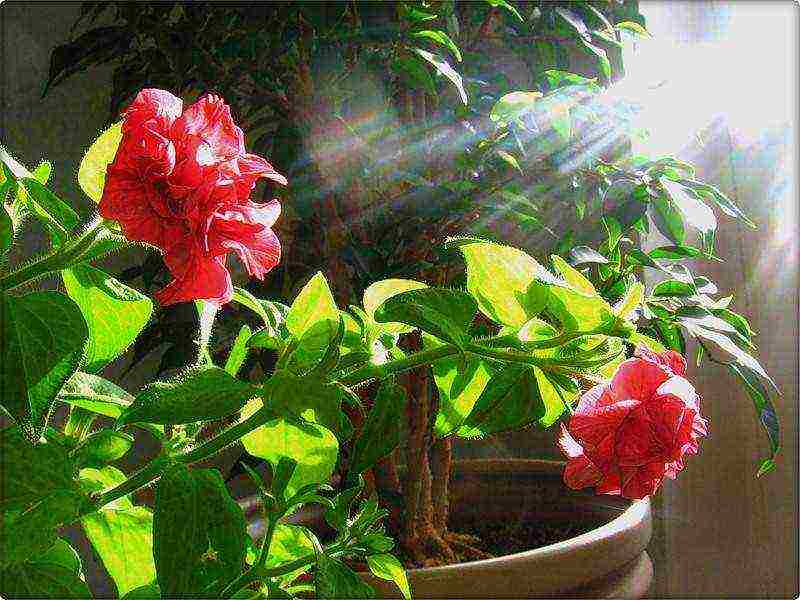 Overwintered cuttings bloom already with the first rays of the warm sun - in February or early March Advantages of preserving petunias in winter (cuttings or adult plants)
Overwintered cuttings bloom already with the first rays of the warm sun - in February or early March Advantages of preserving petunias in winter (cuttings or adult plants)
The main advantages of keeping petunias for the winter:
- early spring flowering. An adult “second year” plant or cuttings taken from it can bloom in February-March. And this will happen even in northern regions such as the Urals, Siberia, etc.
- ease of getting adult seedlings. This does not require sowing small seeds, nursing frail sprouts. The planted stalk, after 2-2.5 weeks, will already bloom.
- preservation until spring of vegetatively propagating varieties of petunias.
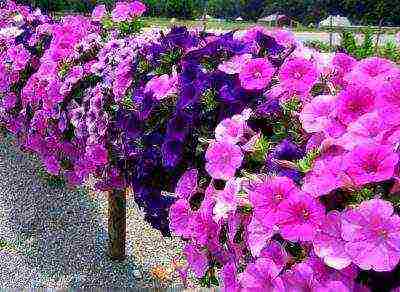
Don't know how to decorate your balcony, loggia, garden, or simply the windowsill of your apartment? Then this article is for you. We will tell you about the beautiful petunia, which is perfect for decoration.
Petunia is a herbaceous perennial semi-shrub plant of tropical origin. It attracts attention with its large and bright colors. Combines harmoniously with other garden plants. Therefore, it is often used to decorate a garden or terrace. Quite often, flower growers choose it to decorate balconies, loggias and even apartment windowsills.
It is believed that adult petunia is very whimsical, and young sprouts are still fussy.But, despite this, if you approach the process of growing and caring for petunia correctly, everything will work out and you will admire its beautiful flowers for a long time, so in this article we will look at how to grow a plant without mistakes from "A" to "Z" ...
…
How to cultivate correctly?
The best petunia growing technology is:
- Large capacity.
- Regular feeding.
- Sufficient watering.
- Removal of faded flowers.
This is the plant loves loamy soil, but it takes root just as well in ordinary garden soil, and some varieties even in simple soil. But it is best to grow a beauty in a fertile one, which consists of peat, turf, river sand, leafy land. Another great option for growing is adding nitrophoska to the soil.
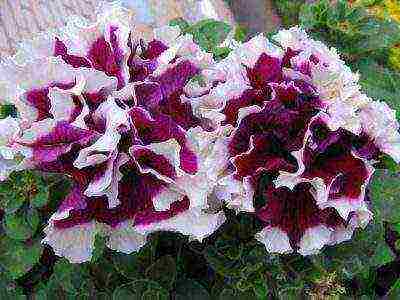 In the garden soil, the greenery of the plant becomes juicier and its growth accelerates, because they are very fond of a slightly acidic environment.
In the garden soil, the greenery of the plant becomes juicier and its growth accelerates, because they are very fond of a slightly acidic environment.
Growing petunias requires special light conditions. She prefers well-lit growing areas, however, blooms can fade in the scorching sun. Small blackouts are also needed.
Lighting is one of the main conditions for growing petunias. Therefore, well-lit areas with blackouts are ideal.
The soil in which the petunia grows should be moist, but not flooded. An excess of moisture will stop its growth. It is also important to ventilate the soil in which the plant grows. Growing these flowers will not be difficult if you just follow the conditions of lighting, watering and soil composition.
Can I grow a plant at home?
Can this plant be grown indoors? Yes, but it's more difficult than just in the ground.
Note! Most importantly, the soil in the growing container should be light and water-absorbing.
Therefore, great attention must be paid to the soil. To do this, it will be enough to mix simple garden soil with purchased soil on a peat base. You can also plant in purchased soil, but after adding a hydrogel to it. The hydrogel must be prepared in advance. It should also be taken into account that such a substrate retains moisture for a long time and you need to be extremely careful with watering the plant. Water only as it dries, especially a recently planted plant.
Growing petunias in a pot or container also implies the correct selection of the container itself for growing. Shrub and terry petunias need 3 liters of land per plant. This means that 3 plants can be planted in a ten-liter container. Large containers retain moisture longer, so it is best to plant multiple plants in one large container. But ampelous, cascading petunias and sufinias need 5 liters per plant.
There must be holes in the container for excess moisture to drain out. If you choose the wrong container, then you can achieve beauty, but not for long. Petunias will first thrive, and then they will survive in such conditions. And they will not delight you with long and lush lashes and abundant flowering.
It is important to pick off the faded flowers from the plant. Secrets of growing petunias:
- Seat selection - it should be a well-lit place with slight blackouts.
- The soil - both ordinary garden and specially prepared using purchased peat-based soil, with the addition of hydrogel, turf, coarse sand.
- Watering and feeding - water every day, especially if you see that the top lump is dry. Best watered in the morning and evening. Petunia does not like stagnant moisture, so take care of good drainage. Feed regularly with mineral fertilizers. The main thing is that it contains potassium and phosphorus - they are responsible for the development of flower buds.
Reproduction methods
Propagation can be done in two ways: growing seedlings from seeds and cuttings.
Seeds
 This is the most common way to breed a plant, even at home. Buy seeds in the shell - they are easier to plant and they are much larger. To begin with, we prepare the soil and maintain the desired temperature at 22-25 ° C. We plant it in a container in which there is always a drainage. Before planting, the drainage should be disinfected with a weak solution of potassium permanganate. Carry out the same procedure with the soil; use special preparations to disinfect it.
This is the most common way to breed a plant, even at home. Buy seeds in the shell - they are easier to plant and they are much larger. To begin with, we prepare the soil and maintain the desired temperature at 22-25 ° C. We plant it in a container in which there is always a drainage. Before planting, the drainage should be disinfected with a weak solution of potassium permanganate. Carry out the same procedure with the soil; use special preparations to disinfect it.
Sow seeds into slightly damp but not damp soil. Before this, it is better to mix the seeds with river sand. Next, cover the container with seeds with glass or foil. We grow seedlings at a temperature of 22 ° C. To prevent the soil from becoming soggy, constantly remove condensation from the glass or change the film.
On a note. Don't forget about good lighting. As soon as small bushes appear and roots get stronger, you can plant it in open ground or continue growing in a greenhouse.
Watch a video about growing petunias. Sowing seeds for seedlings:
By cuttings
It allows the plant to grow much faster. It assumes the presence of an already mature plant. To do this, cut off the side shoots of the petunia. Then cuttings are disinfected and planted in small cups with light soil. We put it in a shaded place. Do not forget about moistening the soil and feeding with mineral fertilizers. Thus, the plant is prepared for wintering. In the spring, we plant it in open ground.
Watch a video about the propagation of petunias by cuttings:
Landing kit
- Priming.
- Planting capacity.
- Disinfectants.
- Seedlings for planting.
- Drainage.
- Mineral fertilizers.
Cultivation
At home
- Sowing seeds - we prepare the soil in advance, warm it up, pour it into a container. We place the seeds in a container with heated soil (do not sprinkle them from the ground, they may not come out). We wet the ground from above. Cover the seeds with glass or foil. We put the container in a warm place with a temperature of 22 ° C.
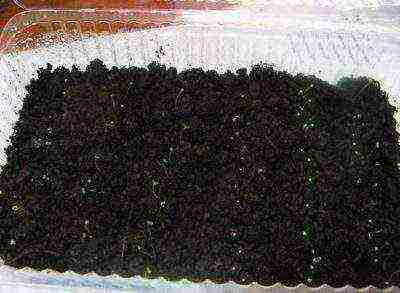 Care in the first days after germination - appear on the 5-10th day. If the ground is dry, water it. Next, mix the containers onto the window (to keep it cooler). We ventilate from time to time (raise the glass or remove the film so that the fungus does not appear).
Care in the first days after germination - appear on the 5-10th day. If the ground is dry, water it. Next, mix the containers onto the window (to keep it cooler). We ventilate from time to time (raise the glass or remove the film so that the fungus does not appear). - Dive - carry out only when the sprout has up to 3 pairs of leaves. Water the soil abundantly and carefully transfer each plant to separate cups.
- Hardening - gradually lower the temperature to about 10 ° C, take out the seedlings for 10-15 minutes. We continue the procedure for several days, you can increase the residence time of the seedlings.
- Pinching - we do it with ordinary scissors, carefully pinch off the growth point of the leaf located after 4 sheets from the bottom. This ends the cultivation of petunias at home. The plant has grown strong enough, hardened and expanded. Now we send it to pots, pots, soil.
In greenhouses
- Sowing seeds - we buy seeds in a special store. We purchase or prepare the substrate ourselves. It contains peat, sand, earth. Wipe everything well and pour with a solution of potassium permanganate. The wet mixture is kept in crates for several days. Before stuffing, we sterilize the boxes with peroxide or potassium permanganate; before sowing, peat is spilled with fugnicides. Seeds are sown in peat, a layer of peat in a box is 2-3 cm and consists of small particles, well sifted and even.
Important! The seeds are not covered with soil so that light falls on them. We also provide additional lighting.
We germinate at a temperature of 22-25 ° C. The required air humidity is 95-98%; to maintain it, we cover the crops with glass or polyethylene. The substrate should not dry out, so we often water it from a sprayer. The water should be kept slightly warmer than the substrate. After germination, lower the temperature to 18-20 ° C.
- Picking - we move the plants into cups. They are in them until the roots take up all the place. At first, the cups are side by side, but as the seedlings grow, they are placed apart from each other.
- Watering and feeding - when the seedlings are dived, you need to make sure that the top layer of the substrate dries up for the next watering. Therefore, the cups are watered once a day or less often. Better to water in the morning and evening. We combine top dressing with watering.
Care rules
Caring for petunia does not require much effort from you. It is enough just to control the watering and feeding of the plant. You need to water at the root of the plant so as not to damage the delicate flowers. The next day after watering, you need to loosen the soil so that a crust does not form. Remove weeds. Feed one week after planting in the ground. We combine watering and feeding. We feed with fertilizers with potassium.
Problems, diseases and pests
Sometimes you may encounter a problem such as yellowing or drying of petunias. If you do not follow the rules of care, the plant can get sick:
- late blight;
- chlorosis;
- black leg;
- gray rot.
They need to be dealt with with special drugs. But it's easier to prevent them from appearing with proper care. If these rules are not followed, then in addition to these diseases, petunia can be affected by viral diseases. There is no cure for them - your plant will die. Of the pests, spider mites, aphids, slugs and thrips are dangerous.
Follow the simple rules for caring for petunias, then you will not have to worry about the health and beauty of your plant. It will always delight you with beautiful flowering.
Petunia in winter - indoors, is it possible to achieve flowering?
-
Everyone knows that petunia is an annual plant. But few people know that you can grow it at home in winter. To do this, you need to transplant petunia before frost appears. It is necessary to cut off all spoiled leaves and remove tall shoots. It is better if the bush is up to 15 cm. At home, petunia behaves with caution, may give new shoots, or may be silent for a while. You can use zircon and epin for complementary foods. In February - March, place the pot in the brightest spot. At the same time, we begin active watering and feeding. Conclusion - in winter, petunia can be grown only so that it gives a beautiful flowering in summer, then you can transplant it into a beautiful flowerpot or garden.
-
Yes it is possible.
Petunia - a beautiful and not whimsical plant, in fact undemanding, easy to care for, therefore it fell in love with many flower growers, it can grow in any area, that is, in flower beds; along sidewalk paths in many cities, as well as on the balconies of apartments and even in indoor conditions, with proper care, abundant flowering is still guaranteed.
Most often, petunia is propagated by seeds, as well as by cuttings, the choice is not great, you can use two methods for reproduction.
Yes, petunia can also be grown indoors, east and west windows are suitable for this.
After all, petunia is a light-loving and thermophilic plant, it is from bright lighting that the abundant flowering of petunias in room conditions depends, or otherwise elongated shoots will not be able to give the formed flowers, flowering will be rare, and high air temperature is also important.
And of course, by the way, watering, most importantly, so that the soil does not dry out and is not waterlogged, in hot weather - it is recommended to water abundantly, in the evening.
Successful cultivation and beautiful flowering.
